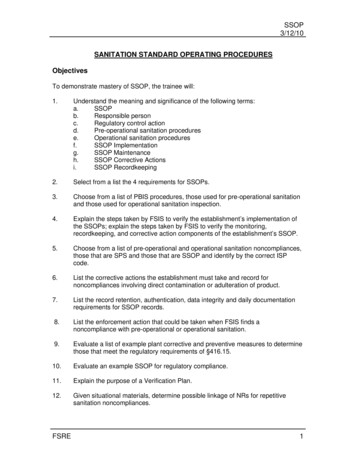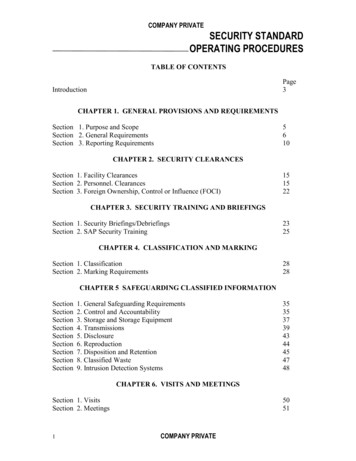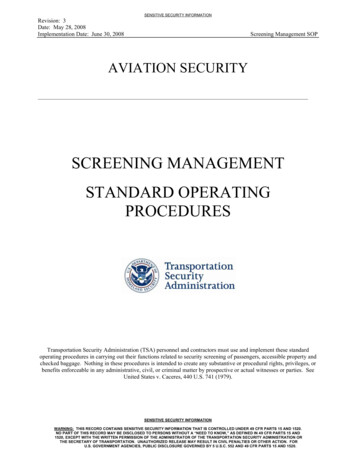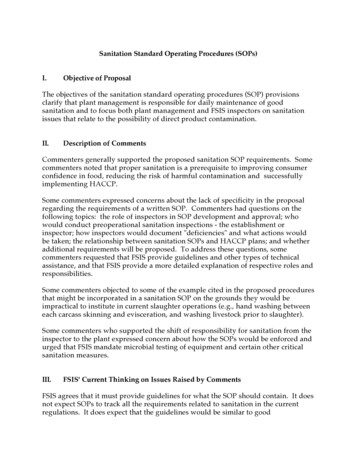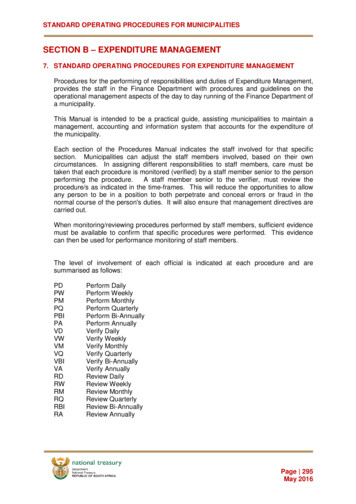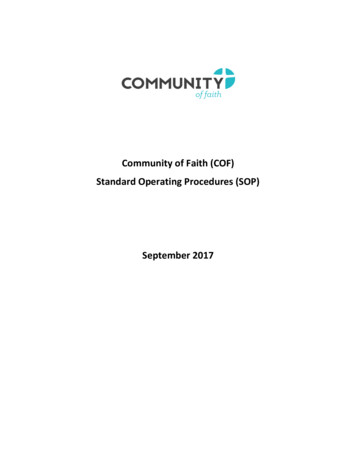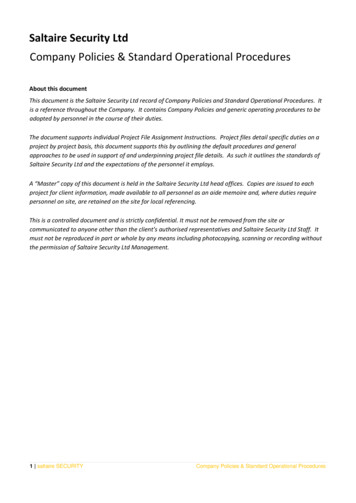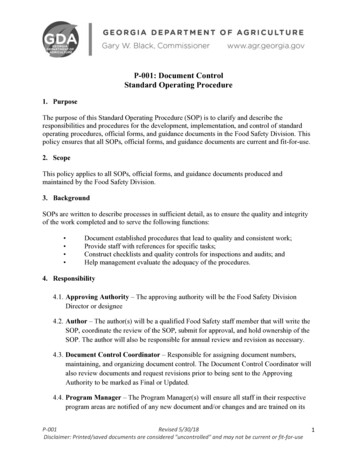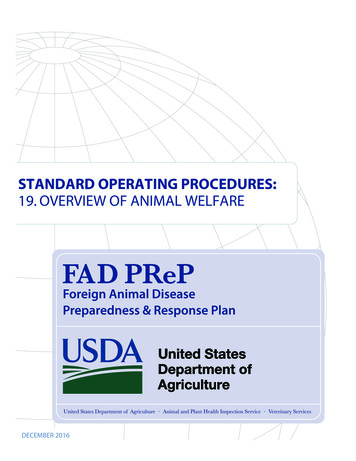
Transcription
STANDARD OPERATING PROCEDURES:19. OVERVIEW OF ANIMAL WELFAREDECEMBER 2016
File name:Lead section:Effective date:FADPReP AnimalWelfare SOPPreparedness and Incident CoordinationVersion number: 2.0December 2016Review date: December 2019The Foreign Animal Disease Preparedness and Response Plan (FAD PReP) Standard OperatingProcedures (SOP) provide operational guidance for responding to an animal health emergency inthe United States.These draft SOPs are under ongoing review. This document was last updated in December 2016.Please send questions or comments to:National Preparedness and Incident CoordinationVeterinary ServicesAnimal and Plant Health Inspection ServiceU.S. Department of Agriculture4700 River Road, Unit 41Riverdale, Maryland 20737Fax: (301) 734-7817E-mail: FAD.PReP.Comments@aphis.usda.govWhile best efforts have been used in developing and preparing the FAD PReP SOPs, the U.S.Government, U.S. Department of Agriculture (USDA), Animal and Plant Health InspectionService, and other parties, such as employees and contractors contributing to this document,neither warrant nor assume any legal liability or responsibility for the accuracy, completeness, orusefulness of any information or procedure disclosed. The primary purpose of these FAD PRePSOPs is to provide operational guidance to those government officials responding to a foreignanimal disease outbreak. It is only posted for public access as a reference.The FAD PReP SOPs may refer to links to various other Federal and State agencies and privateorganizations. These links are maintained solely for the user’s information and convenience. Ifyou link to such site, please be aware that you are then subject to the policies of that site. Inaddition, please note that USDA does not control and cannot guarantee the relevance, timeliness,or accuracy of these outside materials. Further, the inclusion of links or pointers to particularitems in hypertext is not intended to reflect their importance, nor is it intended to constituteapproval or endorsement of any views expressed, or products or services offered, on theseoutside websites, or the organizations sponsoring the websites.Trade names are used solely for the purpose of providing specific information. Mention of atrade name does not constitute a guarantee or warranty of the product by USDA or anendorsement over other products not mentioned.USDA prohibits discrimination in all its programs and activities on the basis of race, color,national origin, sex, religion, age, disability, political beliefs, sexual orientation, or marital orfamily status. (Not all prohibited bases apply to all programs.) Persons with disabilities whorequire alternative means for communication of program information (Braille, large print,audiotape, etc.) should contact USDA’s TARGET Center at (202) 720-2600 (voice andtelecommunications device for the deaf [TDD]).To file a complaint of discrimination, write USDA, Director, Office of Civil Rights, Room326-W, Whitten Building, 1400 Independence Avenue SW, Washington, DC 20250-9410 or call(202) 720-5964 (voice and TDD). USDA is an equal opportunity provider and employer.SOP ManualiiAnimal Welfare
Contents19.1Introduction . 19-119.1.1 Goals . 19-119.2 Purpose. 19-219.3 U.S. Regulatory Authorities for Animal Welfare . 19-219.4 American Veterinary Medical Association . 19-419.4.1 Animal Welfare Principles . 19-419.4.2 Humane transport of Equines AVMA Policy . 19-519.5 World Organization for Animal Health: Terrestrial and Aquatic AnimalHealth Codes . 19-519.6 USDA APHIS Animal Welfare Response Roles and Responsibilities . 19-619.7 Animal Handling and Movement. 19-619.8 Euthanasia and Mass Depopulation . 19-819.8.1 Euthanasia . 19-819.8.2 Mass Depopulation . 19-819.9 Biosecurity Considerations . 19-9Attachment 19.A Additional Resources and References . 19-10Attachment 19.B Abbreviations. 19-12SOP ManualiiAnimal Welfare
19.1 IntroductionConsideration should always be given to the welfare of affected animals prior to, during, andafter a foreign animal disease (FAD) incident or outbreak. Responders will provide humanetreatment of animals at all times during an FAD outbreak, given the extenuating circumstancesof an FAD situation. Instituting standards for appropriate animal care and carrying out thesespecifications requires coordination between animal needs, human needs, societal expectations,environmental concerns, and the challenges surrounding control of the outbreak. The progressionof animal welfare standards should be motivated and guided by ethological, ecological, ethicaland veterinary considerations. 1This standard operating procedure (SOP) provides an overview of general guidance on animalwelfare during an FAD outbreak. This document specifically focuses on the role of officialsinvolved in FAD incidents and outbreaks. The treatment of research, zoo, and show animalsalong with normal producer and facility animal care, while very important, are outside the scopeof this document.Several key USDA APHIS documents complement this SOP and provide further detail whennecessary. This SOP references the following APHIS documents: Foreign Animal Disease Preparedness and Response Plan (FAD PReP)/National AnimalHealth Emergency Management System (NAHEMS): Biosecurity Cleaning and Disinfection (C&D) Mass Depopulation and Euthanasia Health and Safety Personal Protective Equipment (PPE)FAD PReP SOPs: Biosecurity C&D Mass Depopulation and Euthanasia Health and Safety/PPE.These documents are available on the APHIS FAD PReP website: www.aphis.usda.gov/fadprep.19.1.1 Goals19.1.1.1 Preparedness GoalIdentify the resources and training necessary to provide humane treatment to animals duringdisease incidents or outbreaks, particularly if identified presumptive positive for an FAD, which1American Veterinary Medical Association (AVMA). (2016). Joint AVMA-Federation of Veterinarians of Europedian Veterinary Medical Association statement on the roles of veterinarians in ensuring good animal welfare.Retrieved from ment-Animal-Welfare.aspx.SOP Manual19-1Animal Welfare
may include vaccination activities until animals are declared free of disease or euthanized ordepopulated as prescribed by veterinary authorities of affected State(s), Tribal Nation(s), orFederal.19.1.1.2 Response GoalProvide humane treatment to animals during FAD incidents or outbreaks, especially if euthanasiaor mass depopulation is the appropriate disease response strategy. Humane care should beconducted from the time an animal is identified presumptive positive for an FAD, until it isdeclared free from disease or slaughtered as prescribed by veterinary authorities of affectedtSate(s), Tribal Nation(s), or Federal.19.2 PurposeThis SOP provides USDA APHIS Veterinary Services, Incident Command personnel, and otheranimal health response officials’ guidance on animal welfare in the event of an FAD incident oroutbreak in domestic animals. The guidance in this SOP is relevant to animal disease outbreaksof varying size, whether the outbreak is isolated to a single premises or spans across a region tonumerous premises. This SOP only offers guidance and should not replace the advice of asubject matter expert. Always consult a professional prior to implementing any guidance foundin this document.19.3 U.S. Regulatory Authorities for Animal WelfareThis section lists select U.S. laws regarding animal welfare; these are not specific to an FADoutbreak, and this list is not exhaustive. The APHIS Foreign Animal Disease Framework Manual1-0: Roles and Coordination contains more information regarding APHIS’ authority to interveneduring FAD outbreaks. APHIS authority for animal welfare activities during an FAD outbreakcould come from any of the following: Animal Health Protection Act (7 United States Code [U.S.C.] 8301–8322)Congress finds that (1) The prevention, detection, control, and eradication of diseases and pests ofanimals are essential to protect animal health and the health and welfare of thepeople of the United States, the economic interests of the United States livestockand related industries, the environment of the United States, and interstate andforeign commerce of the United States in animals and other articles.(2) Animal diseases and pests are primarily transmitted by animals and articlesregulated under this Act.(3) The health of animals is affected by the methods by which animals andarticles are transported in interstate commerce and foreign commerce.(4) The Secretary must continue to conduct research on animal diseases and pestswhich constitutes a threat to the livestock of the United States.(5) All animals and articles regulated under this Act are in or affect interstatecommerce or foreign commerce, and regulation by the Secretary and cooperationby the Secretary with other nations, States or other jurisdictions, or persons arenecessary to prevent and eliminate burdens on interstate commerce and foreignSOP Manual19-2Animal Welfare
commerce, to regulate effectively interstate commerce and foreign commerce,and to protect the agriculture, the environment, the economy, and the health andwelfare of the people of the United States. 2 Animal Welfare Act (7 U.S.C.) 2131–2159)Congressional statement of policy The Congress finds that animals and activities which are regulated under thischapter are either in interstate or foreign commerce or substantially affect suchcommerce or the free flow thereof, and that regulation of animals and activitiesas provided in this chapter is necessary to prevent and eliminate burdens uponsuch commerce and to effectively regulate such commerce, in order—(1) to insure that animals intended for use in research facilities or for exhibitionpurposes or for use as pets are provided humane care and treatment;(2) to assure the humane treatment of animals during transportation in commerce;and(3) to protect the owners of animals from the theft of their animals by preventingthe sale or use of animals which have been stolen.The Congress further finds that it is essential to regulate, as provided in thischapter, the transportation, purchase, sale, housing, care, handling, and treatmentof animals by carriers or by persons or organizations engaged in using them forresearch or experimental purposes or for exhibition purposes or holding them forsale as pets or for any such purpose or use. 3 Humane Methods of Livestock Slaughter Act (7 U.S.C. 1901–1907)Congress findings The Congress finds that the use of humane methods in the slaughter of livestockprevents needless suffering; results in safer and better working conditions forpersons engaged in the slaughtering industry; brings about improvement ofproducts and economies in slaughtering operations; and produces other benefitsfor producers, processors, and consumers which tend to expedite an orderly flowof livestock and livestock products in interstate and foreign commerce. It istherefore declared to be the policy of the United States that the slaughtering oflivestock and the handling of livestock in connection with slaughter shall becarried out only by humane methods. 4 Horse Protection Act (15 U.S.C. 1821-1831)The Congress finds and declares that 2U.S.C. Title 7—Agriculture: Chapter 109—Animal health protection. (2013). In U.S. Government PublishingOffice. Retrieved from tml/USCODE-2013-title7-chap109sec8301.htm.3U.S.C. Title 7—Agriculture: Chapter 54—Transportation, sale, and handling of certain animals. (2013). In U.S.Government Publishing Office. Retrieved from ml/USCODE-2013-title7-chap54.htm.4U.S.C. Title 7—Agriculture: Chapter 48—Humane methods of livestock slaughter. (2011). In U.S. GovernmentPublishing Office. Retrieved from tml/USCODE-2011title7-chap48-sec1901.htm.SOP Manual19-3Animal Welfare
(1) the soring of horses is cruel and inhumane;(2) horses shown or exhibited which are sore, where such soreness improves theperformance of such horse, compete unfairly with horses which are not sore;(3) the movement, showing, exhibition, or sale of sore horses in intrastatecommerce adversely affects and burdens interstate and foreign commerce;(4) all horses which are subject to regulation under this chapter are either inintrastate or foreign commerce or substantially affect such commerce; and(5) regulation under this chapter by the Secretary is appropriate to prevent andeliminate burdens upon commerce and to effectively regulate commerce. 519.4 American Veterinary Medical AssociationThe AVMA is an important veterinary authority and provides key guidance regarding the healthand welfare of animals.19.4.1 Animal Welfare PrinciplesAnimal welfare during an FAD incident is based on best practices, given the extenuatingcircumstances of an FAD incident. The AVMA offers the following eight integrated principlesfor developing and evaluating animal welfare policies, resolutions, and actions: The responsible use of animals for human purposes, such as companionship, food, fiber,recreation, work, education, exhibition, and research conducted for the benefit of bothhumans and animals, is consistent with the Veterinarian’s Oath. Decisions regarding animal care, use, and welfare shall be made by balancing scientificknowledge and professional judgment with consideration of ethical and societal values. Animals must be provided water, food, proper handling, health care, and an environmentappropriate to their care and use, with thoughtful consideration for their species-typicalbiology and behavior. Animals should be cared for in ways that minimize fear, pain, stress, and suffering. Procedures related to animal housing, management, care, and use should be continuouslyevaluated, and when indicated, refined or replaced. Conservation and management of animal populations should be humane, sociallyresponsible, and scientifically prudent. Animals shall be treated with respect and dignity throughout their lives and, whennecessary, provided a humane death.5U.S.C. Title 15—Commerce and trade: Chapter 44—Protection of horses. (2011). In U.S. Government PublishingOffice. Retrieved from html/USCODE-2011-title15-chap44sec1821.htm.SOP Manual19-4Animal Welfare
The veterinary profession shall continually strive to improve animal health and welfarethrough scientific research, education, collaboration, advocacy, and the development oflegislation and regulations. 619.4.2 Humane transport of Equines AVMA PolicyThe AVMA believes conveyances used to transport equines must ----Be designed, constructed and maintenance to protect the health and welfare ofthe equines being transported at all times;Accommodate segregation of stallions and aggressive equines so that no stallionor aggressive equines can come into contact with other equines on theconveyance;Have sufficient interior height to allow each equine on the conveyance to standwith its head extended to its fullest normal postural height;Not comprise animal cargo space that is divided into two or more stacked levels(conveyances with collapsible floors may be configured to transport equines onone level only, so long as the collapsed configuration meets the heightrequirements previously specified);Provide adequate ventilation;Contain no sharp protrusions that can injure horses;Be equipped with doors and ramps of sufficient size and location to allow safeloading and unloading;Be loaded so that each equine is provided with sufficient space to shift itsweight as needed, and is not crowded in a way that is likely to cause injury ordiscomfort; andAfford secure footing for equines during loading, offloading, and transport. 719.5 World Organization for Animal Health: Terrestrial and AquaticAnimal Health CodesThe World Organization for Animal Health (OIE) standards include the Terrestrial AnimalHealth Code (Terrestrial Code) and the Aquatic Animal Health Code (Aquatic Code). An ad hocGroup of independent experts provides recommendations for new standards or the revision ofexisting standards to the appropriate Specialist Commission (usually consisting of 6 people)—either the Terrestrial Animal Health Standards Commission (Code Commission) or the AquaticAnimal Health Standards Commission (Aquatic Animals Commission). These SpecialistCommissions address comments sent back after the Assembly’s review directly or give to an adhoc or Working Group, such as the Animal Welfare Working Group, who assists in addressingthe remarks. The Assembly (representing the 180 OIE Member Countries and Territories) meetsannually at the OIE General Session where they approve the newly recommended or revisedstandards. A typical turnaround time for adoption of new standards takes approximately 2 years. 86AVMA. (2016). AVMA Animal Welfare Principles. Retrieved from -Welfare-Principles.aspx.7AVMA. (2016). Humane transport of equines policy. Retrieved from sport-of-Equines.aspx.8OIE. (2016). Procedures used by the OIE to set standards and recommendations for the international trade, with afocus on the Terrestrial and Aquatic Animal Health Codes. In Standard-Setting: The Codes. Retrieved fromSOP Manual19-5Animal Welfare
Currently, the adopted animal welfare standards are incorporated into 11 elements of theTerrestrial Code and into 3 elements of the Aquatic Code. These standards include the latestscientific research and cover the following: Terrestrial Animal Health Code: 9 Transport of animals by land Transport of animals by sea Transport of animals by air Slaughter of animals Killing of animals for disease control purposes Stray dog population control Use of animals in research and education Animal welfare and beef cattle production systems Animal welfare and broiler chicken production systems Animal welfare and dairy cattle production systems Welfare of working equids.Aquatic Animal Health Code: 10 Welfare of farmed fish during transport Welfare aspects of stunning and killing of farmed fish for human consumption Killing of farmed fish for disease control purposes.19.6 USDA APHIS Animal Welfare Response Rolesand ResponsibilitiesWithin the Unified Incident Command, there may be one or more individuals directlyaccountable for overseeing animal welfare on a premises. Animal welfare responsibilities mayfall under the Euthanasia Group or within the Site Manager position as designated per theincident or outbreak. Even with designated oversight, all response personnel are responsible forensuring animals are treated humanely and for maintaining awareness for specific issues directlyrelated to the disease event.19.7 Animal Handling and MovementA part of animal welfare is animal handling/movement. Livestock and poultry should be handledand managed appropriately in accordance with their innate behaviors and husbandry rnationa Standard Setting/docs/pdf/A OIE procedures standards2016.pdf.9OIE. (2016). Animal welfare. In Terrestrial Animal Health Code (Section 7). Retrieved from http://www.oie.int.10OIE. (2016). Welfare of farmed fish. In Aquatic Animal Health Code (Section 7). Retrieved fromhttp://www.oie.int.SOP Manual19-6Animal Welfare
They should also be handled in a way that avoids as much stress as possible to prevent injuries toanimals and personnel.Calm animals are easier to handle and move than excited animals. Animals can become agitatedvery quickly, but can require 20 to 30 minutes to settle down again, creating a challenge forhandling. 11 Animals that are calm will move without difficulty through appropriately designedsystems, with driving and prodding utilized as little as possible. 12 Animals should not be forcedto move any quicker than a normal rate of walking speed and should be handled on surfacesdesigned to prevent slipping. They should be handled in a quiet manner without loud agitation,and must be restrained in such a way that doesn’t cause injury or needless pain. Increased safety,efficiency, and animal welfare can be achieved through reducing stress and alarm during animalhandling and movement. 13Non-ambulatory animals should be euthanized prior to being moved to the disposal location as ahumane consideration. Handling livestock less before euthanasia that are not accustomed toconsiderable interactions with humans, may bring about a more humane death. 14 Whentransporting animals, specific guidelines should be considered to ensure their well-being. Table 1provides examples of specific items to take into account when managing the transportation oflivestock.Table 1. Items to be Considered When Transporting Animals 15ItemConsiderations for Animal TransportTemperatureManagementLivestock and poultry should be protected against temperature extremes. Load densitiesshould be decreased to lessen heat stress and ensuring animals are dry and providingwind protection is important when air or wind chill temperatures are low.TrailerMaintenanceTrailers should be kept clean and in good repair. They should have non-slip floors toprovide additional traction and be designed in such a manner to ensure that theconveyance incurs no damage on the animals (e.g., no sharp edges or joints; paneling ofproper width such that limbs are not trapped).DrivingPracticesDriving with caution, by avoiding sudden stops and fast acceleration, can help to preventbruises, injuries, and stress.11Grandin, T., & American Meat Institute Animal Welfare Committee. (2010). Recommended Animal HandlingGuidelines and Audit Guide: A Systematic Approach to Animal Welfare. Retrieved Action/i/58425.12Grandin, T., & American Meat Institute Animal Welfare Committee. (2010). Recommended Animal HandlingGuidelines and Audit Guide: A Systematic Approach to Animal Welfare. Retrieved Action/i/58425.13For more information on handling considerations, please see the FAD PReP/NAHEMS Guidelines: MassDepopulation & Euthanasia available on the APHIS FAD PReP website: www.aphis.usda.gov/fadprep.14For more information on handling and movement considerations for euthanasia, please see the FAD PReP/NAHEMS Guidelines: Mass Depopulation & Euthanasia available on the APHIS FAD PReP website:www.aphis.usda.gov/fadprep.15Grandin, T., & American Meat Institute Animal Welfare Committee. (2010). Recommended Animal HandlingGuidelines and Audit Guide: A Systematic Approach to Animal Welfare. Retrieved Action/i/58425.SOP Manual19-7Animal Welfare
Loading/UnloadingOverloading can cause bruising, death, or injury; therefore vehicles should be stocked ata density commensurate with the accepted carrying capacity of the conveyance. Animalsshould be unloaded immediately, however, rushing livestock while unloading can be asignificant cause of bruises.There also are species specific handling methods to take into consideration. Please refer tosector-specific documents, AVMA guidance, and the FAD PReP/NAHEMS Guidelines: MassDepopulation & Euthanasia for more information. The use of knowledgeable and skilledpersonnel for handling and management of animals is strongly recommended. 1619.8 Euthanasia and Mass DepopulationEuthanasia and/or mass depopulation may be utilized during FAD outbreaks to euthanizeinfected (and at times, contact) animals in order to control, contain, and eradicate the disease toprotect the nation’s food supply, animal agriculture, and animal health. To the extent possible,animals should be euthanized or depopulated in ways that minimize fear, pain, stress, andsuffering.Mass depopulation is a distinct practice and is not synonymous with euthanasia. Massdepopulation is a method by which large numbers of animals must be destroyed quickly andefficiently in an outbreak or other emergency, with as much consideration given to the welfare ofthe animals as possible. Euthanasia involves transitioning an animal to death as painlessly andstress-free as possible.19.8.1 EuthanasiaEuthanasia should occur in such a way that minimizes an animal’s pain and stress. To meet thisrequirement, the animal should be rendered unconscious as quickly as possible. The method ofeuthanasia should be consistent with the current AVMA Guidelines for the Euthanasia ofAnimals: 2013 Edition based on the following criteria:(1) ability to induce loss of consciousness and death with a minimum of pain and distress;(2) time required to induce loss of consciousness; (3) reliability; (4) safety of personnel;(5) irreversibility; (6) compatibility with intended animal use and purpose; (7) documentedemotional effect on observers or operators; (8) compatibility with subsequent evaluation,examination, or use of tissue; (9) drug availability and human abuse potential;(10) compatibility with species, age, and health status; (11) ability to maintain equipmentin proper working order; (12) safety for predators and scavengers should the animal’scarcass be consumed; (13) legal requirements; and (14) environmental impacts of themethod or disposition of the animal’s remains. 1719.8.2 Mass DepopulationMass depopulation is employed in response to animal health emergencies, including FADs, inorder to contain or limit the spread of the FAD agents through elimination of infected or16Grandin, T., & American Meat Institute Animal Welfare Committee. (2010). Recommended Animal HandlingGuidelines and Audit Guide: A Systematic Approach to Animal Welfare. Retrieved Action/i/58425.17AVMA. (2013). AVMA Guidelines for the Euthanasia of Animals: 2013 Edition. Retrieved hanasia.pdf.SOP Manual19-8Animal Welfare
potentially infected animals. Qualified personnel should perform depopulation with the quickest,safest, and most humane procedures possible.The USDA APHIS recognizes the AVMA definition of mass depopulation as:Method by which large numbers of animals must be destroyed quickly and efficiently withas much consideration given to the welfare of the animals as practicable, but where thecircumstances and tasks facing those doing the depopulation are understood to beextenuating. 18For further details on euthanasia and mass depopulation methods, see the FAD PReP/NAHEMSGuidelines: Mass Depopulation and Euthanasia and disease specific FAD PReP MassDepopulation and Euthanasia SOPs.19.9 Biosecurity ConsiderationsBiosecurity protocols are meant to prevent the risk of introducing and spreading disease-causingpathogens within animal populations. Biosecurity must be considered during any and allresponse activities. Movements under quarantine on Infected, Contact, and Suspected Premises,during a FAD outbreak, are highly restricted. Movement is prohibited unless a permit is issuedby the Incident Command for either critical movements (e.g., animal welfare) or for essentialmovements related to response activities. A site-specific biosecurity plan addresses the control ofall movements that should be followed during an incident, and should explicitly take intoaccount animal welfare considerations (e.g., movement of feed on to a premises).Biosecurity measures help ensure that response personnel working on an Infected or ContactPremises with livestock and poultry do not spread disease when they enter or leave the premises.Clothes, boots, vehicles, and equipment may become fomites of infection. Therefore, allpersonnel entering an Infected, Contact, or any other Premises within the Control Area must dondisease or function appropriate PPE and then doff the same PPE and undergo proper C&D/viruselimination procedures upon exit. This includes for any animal welfare activities. Any questionsregarding appropriate PPE should be directed through the Unified Incident Commandorganizational structure.For more information on biosecurity considerations, please see the FAD PReP/NAHEMSGuidelines: Biosecurity and the FAD PReP Biosecurity SOP. These document are available onthe APHIS FAD PReP website: www.aphis.usda.gov/fadprep.18AVMA. (2016). Poultry Depopulation. Retrieved from pulation.aspx.SOP Manual19-9Animal Welfare
Attachment 19.A Additional Resources and ReferencesAmerican Veterinary Medical Association (AVMA). (2016). AVMA Animal Welfare Principles.Retrieved from -WelfarePrinciples.aspx.American Ve
Procedures (SOP) provide operational guidance for responding to an animal health emergency in . Office of Civil Rights, Room 326-W, Whitten Building, 1400 Independence Avenue SW, Washington, DC 20250-9410 or call (202) 720-5964 (voice and TDD). USDA is an equal opportunity provider and employer. . SOP Manual 19-1 Animal Welfare

